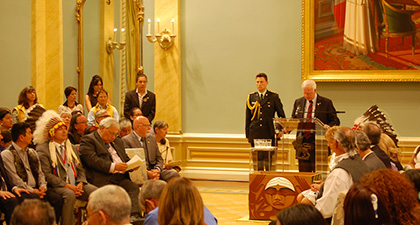A few weeks ago, I joined other Jews in carrying a Jewish/Aboriginal solidarity banner at the Walk for Reconciliation in Ottawa. The walk – 7,000-strong – served as the launch for the Truth and Reconciliation Commission’s (TRC) final event, the summation of an exhausting seven years of testimony gathering under the leadership of Justice Murray Sinclair.
I felt compelled to participate in some way, despite my superficial state of knowledge on the 150-year residential schools phenomenon and the emotional, physical, and sexual abuse faced by those extracted from their families and scrubbed of their cultures, languages, and sense of dignity.
In my interactions with the commission – most notably as an honorary youth witness at a TRC event in Toronto in 2012, where my role was to listen to a day of testimony and then offer reflections before an audience of survivors and the friends and family members who came to support them – I was deeply influenced by my upbringing as a justice-minded, socially conscious Jewish Canadian. Clearly I was not alone, and the Canadian Jewish community’s “Statement of Solidarity” with the TRC is one concrete indicator of my fellow community members’ willingness to take part in the reconciliation process.
In configuring our involvement and solidarity, many of us may have been guided by another famous walker, Rabbi Abraham Joshua Heschel, who marched side by side with Martin Luther King Jr. from Selma to Montgomery. Reflecting on that experience, Heschel said, “the march was about protest and prayer. Legs are not lips and walking is not kneeling. And yet our legs uttered songs. Even without words, our march was worship. I felt my legs were praying.”
The challenge now – for our legs and our lips – is that pursuing genuine reconciliation will require sustained commitment from Victoria to Halifax, from the prime minister to the health worker in Kitigan Zibi to, yes, civil society leaders, including those in Canada’s faith communities. It will require a commitment to not only look forward, but also to closely and honestly examine the obstacles that currently hinder the relationship between indigenous and non-indigenous citizens. On one level, mistrust and prejudices leading to inequalities both real and perceived, and on another level, protracted states of physical and mental health emergency and insecurity, manifested most shockingly in the situation of missing and murdered indigenous women. No one can say we did not know.
It is impossible to fully understand the relationship between the residential schools experience and the current realities on and off reserve, yet one thing is clear: the TRC final report must not gather dust, but must serve as the bedrock and blueprint for action. In calling for Canada to adopt and implement the United Nations Declaration on the Rights of Indigenous Peoples “as the framework for reconciliation,” the TRC commissioners are speaking in a clear voice: the responsibility of governments to advance reconciliation is also the responsibility to protect the rights of citizens.
This is the hard work. Walking for reconciliation was a no-brainer, but answering the call of the TRC will require considerably more thought and drive. Evoking Heschel once again, we “must choose between interfaith and inter-nihilism. Between a shared hope that says together we can shape a brighter future, or a shared cynicism that says our world is simply beyond repair.”
With respect to Jewish-Aboriginal relations, there is a great deal of work to be maintained and expanded upon, including local-level institutional relationships. And there are opportunities for both of our communities to learn from one another – such as when the Centre for Israel and Jewish Affairs co-presented with the TRC a discussion between survivors of both the Shoah and residential schools regarding “trauma and injustice, healing and recovery, the work of keeping memories alive and reconciliation.” Or the Assembly of First Nations National Youth Council’s gracious invitation to several of my fellow Jewish student leaders to attend their annual summit.
Of all that is exalted in Judaism, nothing compares to the importance of education and the pursuit of justice – Tzedek, tzedek tirdof. I would encourage community members to consider how we might use our energies and resources to support the work of individuals pursuing justice for First Nations individuals. This includes children, who according to the executive director of the First Nations Child and Family Caring Society of Canada Cindy Blackstock’s “I am a witness” campaign, have suffered as a result of “a longstanding pattern of providing less government funding for child welfare services to First Nations children on reserves than is provided to non-Aboriginal children.”
As the reconciliation process moves from report to reality, issues will doubtlessly arise that will stir emotions and encumber progress. As evidenced by the ongoing debate over whether the residential schools constituted a sustained “cultural genocide” – and over the normative implications of such language, endorsed by none other than Chief Justice Beverley McLachlin – the Jewish community will not be left unaffected. While I believe this is an important conversation, it would be irresponsible to allow rhetorical quandaries to cause dithering and delay on implementing the recommendations of the TRC.
I am glad I walked for reconciliation. Yet seven years after the Truth and Reconciliation Commission heard its first survivor testimony, the real work can and must begin.
Adam Moscoe is a member of the Young Leaders Circle of the Centre for Israel and Jewish Affairs, and the Ottawa Chair of Global Dignity.
